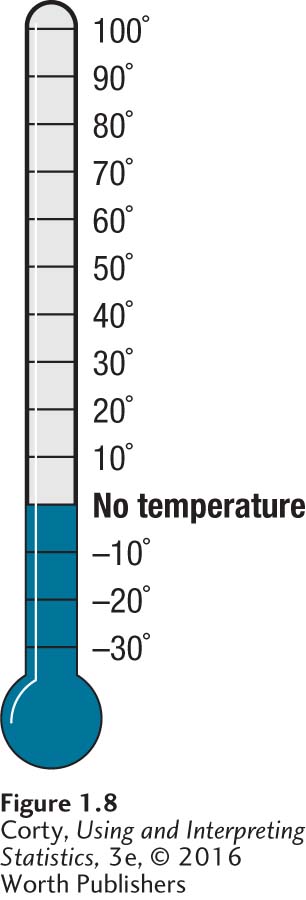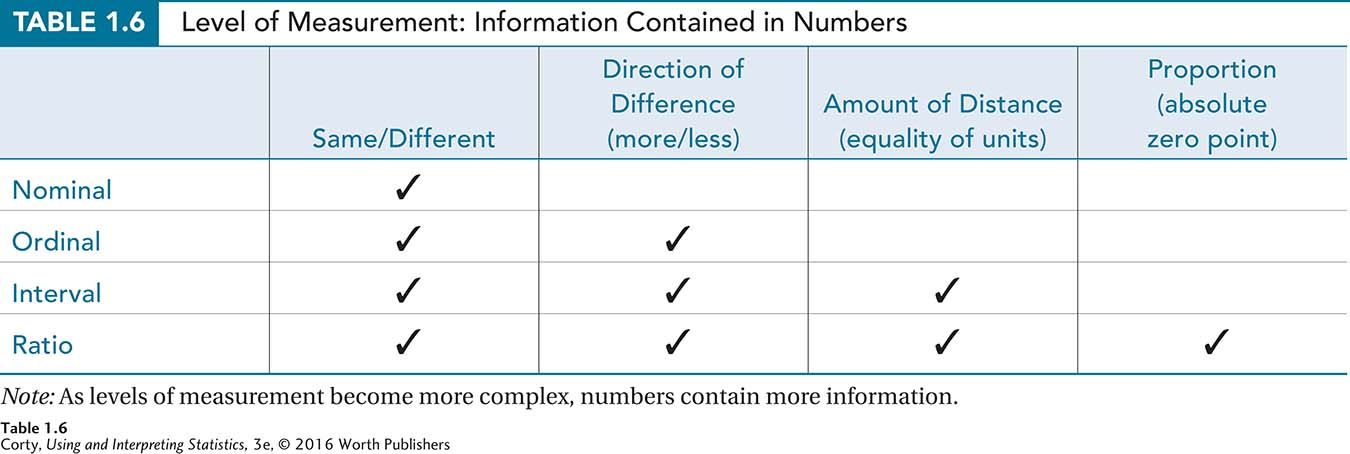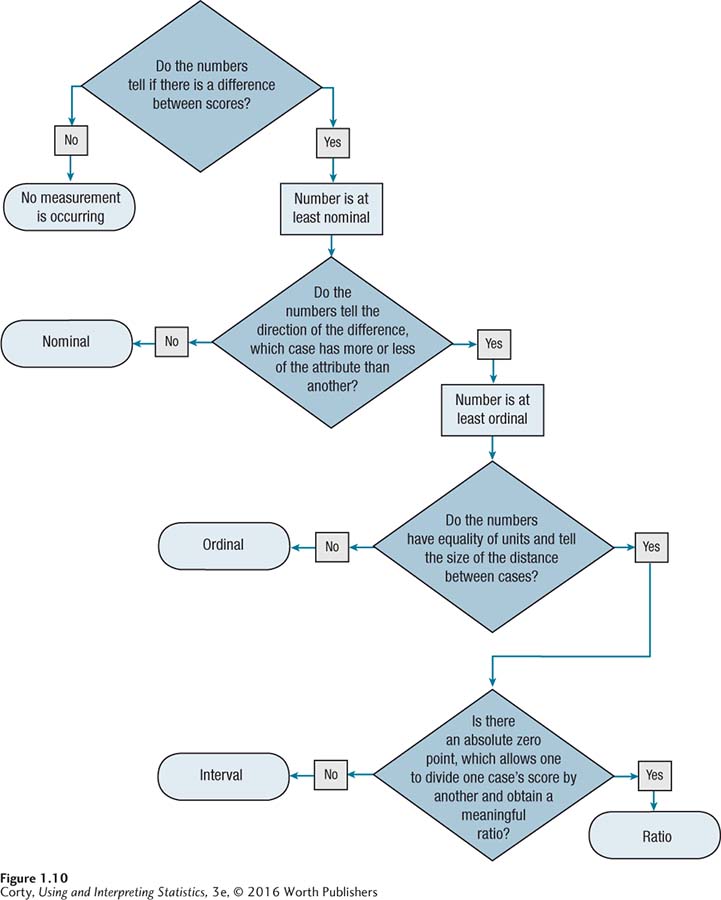1.3 Levels of Measurement
Statistical techniques are performed on data: numbers. All numbers may look alike, but there are different types of numbers that vary in how much information they contain. The type of number determines the statistics that can be used, so it is important to know about the different types of numbers, called levels of measurement.
Statisticians divide numbers into four levels of measurement: nominal, ordinal, interval, and ratio. As the numbers move up the hierarchy, from nominal to ratio, they become more complex and contain more information.
Statisticians divide numbers into four levels of measurement: nominal, ordinal, interval, and ratio. As the numbers move up the hierarchy, from nominal to ratio, they become more complex and contain more information. Nominal numbers contain only one piece of information, while ratio numbers contain four pieces of information.
Before learning about the four levels of measurement, Figure 1.7 shows a mnemonic to help remember them in the correct order: noir. Noir is French for “black” and allows one to remember nominal, ordinal, interval, and ratio in order from least complex to most complex.
Nominal Numbers

Nominal-level numbers, the simplest level of measurement, sort cases into categories. The numbers used for each category are arbitrary and provide no quantitative information. The numbers simply indicate whether two things are the same or different. Cases are assigned different numbers if they possess different qualities, and they are assigned the same number if they possess the same quality. For example, the race of participants in a study could be measured by assigning a 1 to whites, 2 to blacks, 3 to Native Americans, 4 to Asians, and 5 to Pacific Islanders. If Jack is a 1 and Jill is a 1, then both are white. If Simone is a 1 and Susanne is a 2, then they are of different races.
Race is a variable that social scientists regularly measure. Other variables psychologists use that are measured at the nominal level are factors like sex (male or female), handedness, and psychiatric diagnosis.
There is not much math that can be done with nominal numbers because the numbers are arbitrary. The researcher studying race could just as easily assign the number 7 to whites, 22 to blacks, 0.78 to Native Americans, and so on. The numbers are arbitrary, so it doesn’t make sense to find the “average” race of a group of people. However, the researcher could count how many are 1s (white), 2s (black), 3s (Native American), and so on.
If two cases receive different numbers, then those numbers reflect a difference in the attribute being measured. If the numbers also tell the direction of the difference, which case has more of the attribute and which has less, then one has moved to the next level of measurement, referred to as ordinal.
Ordinal Numbers
Ordinal-level numbers reveal whether cases possess more or less of some characteristic. In ordinal measurement, one might order the objects being measured from lowest to highest (or vice versa) in terms of how much of the characteristic each possesses. Then, ranks are assigned. For example, it is common to say that the person with the fastest time in a race came in first place, the next fastest person was in second place, and so on. Thus, ordinal numbers give information about the direction of differences, about which case possesses more or less of the attribute being measured.
But, ordinal numbers don’t give any information about how much distance separates cases with different ranks. For example, the most populous state in the United States is California, with about 39 million people. It is followed by Texas (27 million) and Florida (20 million). Note that the distance between rank 1 and 2 is 12 million people and the distance from rank 2 to 3 is 7 million people, yet both are one rank apart. Sometimes the distance between two adjacent scores is large, and sometimes it is small. Ordinal numbers give no information about how far apart cases are.
Though ordinal numbers are still limited in the math one can perform, there are special statistics developed to use with ordinal measures. Here are some ordinal variables psychologists use:
Class rank and birth order, two variables psychologists use, are ordinal. In fact, most variables with the term rank or order in them are ordinal.
Individual items on the Apgar scale, a way of measuring the health of newborns, are ordinal. For example, on the Apgar scale, a score of 0 means the pulse is less than 60, 1 is used if the pulse is from 60 to 100, and 2 means the pulse is greater than 100.
Page 18Many rating scales are ordinal. For example, a question on a survey asking whether one drinks alcohol never (0), rarely (1), every month (2), every week (3), or every day (4) would be ordinal.
Interval Numbers

Interval-level numbers tell how much of the characteristic being measured a case possesses. They contain meaningful information about distance between cases in addition to information about same/different and more/less. That is, they reveal how much of a difference exists between two cases.
Interval-level numbers can tell how far apart two cases are because there is equality of units. Equality of units means that the interval used on the scale is a consistent width along the whole length of the scale. For example, on a Fahrenheit temperature scale, the distance from 31° to 32° is the same as the distance from 211° to 212°.
If an attribute is measured on an interval scale, one can add and subtract the numbers, as well as calculate averages. However, one can’t divide a specific interval-level measure by another interval-level measure. For example, it is not legitimate to say that an 80° summer day is twice as warm as a 40° winter day. Proportions can’t be calculated because interval-level scales have arbitrary zero points. On an interval scale, a value of zero does not mean the absence of the attribute being measured. If a person takes a paper-and-pencil IQ test and answers all the questions incorrectly, one wouldn’t say that he or she has no intelligence. Similarly, if the outside temperature on a winter day is 0°F, shown in Figure 1.8, it would be silly to state that there is no temperature that day.
A lot of the variables that psychologists measure, factors like intelligence and personality, are interval-level numbers. Statisticians prefer interval-level numbers over ordinal-level numbers and nominal-level numbers because interval-level numbers contain more information and more math can be done on them. For example, as already mentioned, one can find an average for a variable measured on an interval scale. More statistical techniques have been developed for interval-level data than for nominal and ordinal data.
Ratio Numbers

Ratio-level numbers have everything interval-level numbers have, but they also have an absolute zero point, a real zero point. Absolute zero indicates that a score of 0 means none of the attribute being measured is present. A simple example is speed. On a speed scale, such as miles per hour (mph), a value of zero means that the object is not moving. It has zero speed. An absolute zero point means one can divide two ratio-level numbers, to turn them into a proportion. If José is driving a car at 10 mph and Celeste is driving at 20 mph, one can legitimately say that her car is going twice as fast.
Most of the time, absolute zero points exist only for physical variables, not psychological ones. For example, height, weight, speed, and population all have absolute zero points. Also, things like age, cholesterol level, and pollution level have absolute zero points. There are some psychologically relevant variables—heart rate, crime rate, and length of marriage—that are ratio level. But, many other psychological variables—for instance, intelligence, masculinity, and conscientiousness—are not ratio level.
If a zero on a ratio scale means that none of the attribute is present, it seems like it would be impossible to have a negative ratio-level number. But, it is possible for ratio numbers to be negative. Anyone who’s ever overdrawn a checking account (see Figure 1.9) and had a negative balance has had firsthand experience with this phenomenon.
An absolute zero point is necessary for a ratio-level measure, but a ratio-level measure must also have equality of units. Table 1.6 shows that there is a hierarchy to the levels of measurement where each more complex level has all the qualities of the preceding one.

Knowing the level of measurement of a variable is important. Figure 1.10 is a flowchart that shows four successive questions that can be used to determine a variable’s level of measurement. As long as the answer to a question is yes, go on to ask the next question. When one hits a “no,” stop. The last “yes” gives the level of measurement.

A Common Question
Q How can variables like height and weight have absolute zero points?
A No person will ever be zero inches tall or weigh zero pounds, so that value would never be assigned to a case, but that isn’t what absolute zero means. An absolute zero point means that the zero on the scale represents an absence of the characteristic.
Worked Example 1.2
For practice figuring out level of measurement, imagine an end-of-semester test in an introductory psychology class that is meant to measure knowledge of psychology. It is 50 items long and each item is worth 2 points. Is this test measuring at the nominal, ordinal, interval, or ratio level?
To figure out the problem, think of two students, with two different scores on the test, one with an 80 and one with a 90, as shown in Figure 1.11. The test scores tell same vs. different, 80 is different from 90, so this test is measuring knowledge of psychology at least at the nominal level. One can also tell the direction of the difference, that one student did better than the other (90 is more than 80), so this test is measuring at least at the ordinal level. There was equality of units (each question was worth 2 points), so one can speak meaningfully of how much better one student did than the other. The test is measuring at least at the interval level.

The final question is whether there is an absolute zero point. It was stated earlier that this test was meant to measure knowledge of psychology. If someone got a zero on the test, would that mean this person has zero knowledge of psychology? No! It would just mean that the person didn’t answer those 50 questions correctly. There might be 50 other facts that the person knows. That means this test has an arbitrary zero point, not an absolute one. As the last “yes” answer was at the interval level, one should stop there and conclude that this test measures knowledge of psychology at the interval level.
However, be aware that there is room for disagreement. Someone else may use this test to measure how many of the 50 questions were answered correctly. In that case, the zero point is absolute and the test is measuring at the ratio-level variable. Students don’t like this, but whether a zero point is real or arbitrary can depend on how a test is being used or interpreted.
Practice Problems 1.3
Review Your Knowledge
1.10 List the four levels of measurement, in order from simplest to most complex.
1.11 When a scale moves from ordinal to interval by adding equality of units, what additional information does that scale now provide?
1.12 If a scale has an absolute zero point, what does a zero on the scale represent?
Apply Your Knowledge
For Practice Problems 1.13–1.16, determine what level of measurement the variable is (nominal, ordinal, interval, or ratio).
1.13 Ivan Pavlov gathers a group of dogs, exposes each to its favorite food for 5 minutes, and measures how many milliliters of saliva each dog produces during the 5-minute period. Salivation is being measured at what level?
1.14 At the end of the semester, a professor surveys his students using the following scale with regard to how much of the assigned reading was done: 0 = none, 1 = a bit, 2 = about half, 3 = most, 4 = all. Amount of assigned reading completed is measured at what level?
1.15 Infants who are being reared by heterosexual couples are observed and classified as (a) being attached to the mother, (b) being attached to the father, (c) being attached to both, or (d) being attached to neither. Attachment is being measured at what level?
1.16 A personality psychologist developed a femininity scale. From the list of hundreds of behaviors that are considered feminine, he selected 10. For each of these 10 behaviors, a person completing the scale indicates if he or she engages in the behavior. Each “yes” answer is worth 1 point. Scores on the scale can range from 0 to 10. Femininity is being measured at what level?
